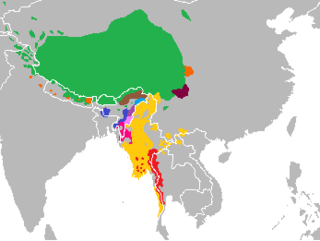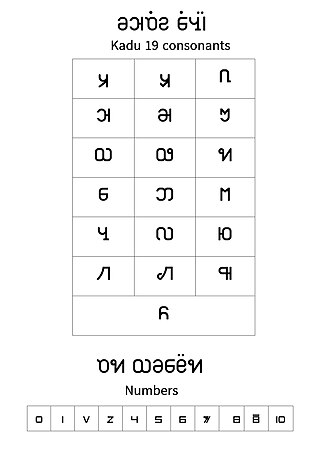Related Research Articles

Sino-Tibetan, also cited as Trans-Himalayan in a few sources, is a family of more than 400 languages, second only to Indo-European in number of native speakers. Around 1.4 billion people speak a Sino-Tibetan language. The vast majority of these are the 1.3 billion native speakers of Sinitic languages. Other Sino-Tibetan languages with large numbers of speakers include Burmese and the Tibetic languages. Other languages of the family are spoken in the Himalayas, the Southeast Asian Massif, and the eastern edge of the Tibetan Plateau. Most of these have small speech communities in remote mountain areas, and as such are poorly documented.
Tani, is a branch of Tibeto-Burman languages spoken mostly in Arunachal Pradesh, Assam, and neighboring regions.
Qiangic is a group of related languages within the Sino-Tibetan language family. They are spoken mainly in Southwest China, including Sichuan and northern Yunnan. Most Qiangic languages are distributed in the prefectures of Ngawa, Garzê, Ya'an and Liangshan in Sichuan with some in Northern Yunnan as well.
The Kuki-Chin–Naga languages are a geographic clustering of languages of the Sino-Tibetan family in James Matisoff's classification used by Ethnologue, which groups it under the non-monophyletic "Tibeto-Burman". Their genealogical relationship both to each other and to the rest of Sino-Tibetan is unresolved, but Matisoff lumps them together as a convenience pending further research.
The Sal languages, also known as the Brahmaputran languages, are a branch of Tibeto-Burman languages spoken in northeast India, as well as parts of Bangladesh, Myanmar (Burma), and China.
The Jingpho-Luish, Jingpho-Asakian, Kachin–Luic, or Kachinic languages are a group of Sino-Tibetan languages belonging the Sal branch. They are spoken in northeastern India, Bangladesh and Myanmar, and consist of the Jingpho language and the Luish languages Sak, Kadu, Ganan, Andro, Sengmai, and Chairel. Ethnologue and Glottolog include the extinct or nearly extinct Taman language in the Jingpo branch, but Huziwara (2016) considers it to be unclassified within Tibeto-Burman.
The Tibeto-Kanauri languages, also called Bodic, Bodish–Himalayish, and Western Tibeto-Burman, are a proposed intermediate level of classification of the Sino-Tibetan languages, centered on the Tibetic languages and the Kinnauri dialect cluster. The conception of the relationship, or if it is even a valid group, varies between researchers.
The Nung or Nungish languages are a poorly described family of uncertain affiliation within the Sino-Tibetan languages spoken in Yunnan, China and Burma. They include:

The Tibeto-Burman languages are the non-Sinitic members of the Sino-Tibetan language family, over 400 of which are spoken throughout the Southeast Asian Massif ("Zomia") as well as parts of East Asia and South Asia. Around 60 million people speak Tibeto-Burman languages. The name derives from the most widely spoken of these languages, Burmese and the Tibetic languages, which also have extensive literary traditions, dating from the 12th and 7th centuries respectively. Most of the other languages are spoken by much smaller communities, and many of them have not been described in detail.
The Kadu people are an ethnic group in Myanmar. They speak the Kadu language. They mostly reside in the country's northwestern hills, centred around Katha, and are ethnolinguistically related to the Ganan and Sak peoples. The Kadu traditionally cultivate rice on irrigated terraces.
Proto-Tibeto-Burman is the reconstructed ancestor of the Tibeto-Burman languages, that is, the Sino-Tibetan languages, except for Chinese. An initial reconstruction was produced by Paul K. Benedict and since refined by James Matisoff. Several other researchers argue that the Tibeto-Burman languages sans Chinese do not constitute a monophyletic group within Sino-Tibetan, and therefore that Proto-Tibeto-Burman was the same language as Proto-Sino-Tibetan.

Kadu or Kado ; is a Sino-Tibetan language of the Sal branch spoken in Sagaing Region, Myanmar by the Kadu people. Dialects are Settaw, Mawkhwin, and Mawteik [extinct], with 30,000 speakers total. Kadu is considered an endangered language, and is closely related to the Ganan and Sak languages.
Sak is a Sino-Tibetan language of the Sal branch spoken in Bangladesh and Myanmar by the Chak people.
Chakpa is an extinct Sino-Tibetan language that was spoken in the Imphal valley of Manipur, India. It belonged to the Luish branch of the Sino-Tibetan family. Chakpa speakers have been shifted to that of Meitei language. Varieties of the language included Sengmai and Andro.
The Burmo-Qiangic or Eastern Tibeto-Burman languages are a proposed family of Sino-Tibetan languages spoken in Southwest China and Myanmar. It consists of the Lolo-Burmese and Qiangic branches, including the extinct Tangut language.
Mruic or Mru–Hkongso is a small group of Sino-Tibetan languages consisting of two languages, Mru and Anu-Hkongso. Their relationship within Sino-Tibetan is unclear.
Proto-Sino-Tibetan (PST) is the hypothetical linguistic reconstruction of the Sino-Tibetan proto-language and the common ancestor of all languages in it, including the Sinitic languages, the Tibetic languages, Yi, Bai, Burmese, Karen, Tangut, and Naga. Paul K. Benedict (1972) placed a particular emphasis on Old Chinese, Classical Tibetan, Jingpho, Written Burmese, Garo, and Mizo in his discussion of Proto-Sino-Tibetan.
Central Tibeto-Burman or Central Trans-Himalayan is a proposed branch of the Sino-Tibetan language family proposed by Scott DeLancey (2015) on the basis of shared morphological evidence.
Ganan is a Sino-Tibetan language of northwestern Myanmar, spoken in Sagaing Region. It belongs to the Luish branch, and is most closely related to the Kadu language of Myanmar, with which it shares 84 to 89% lexical similarity. The Ganan dialects share 95 to 99% lexical similarity.
Taman is an extinct Sino-Tibetan language that was spoken in Htamanthi village in Homalin Township, Sagaing Region, northern Myanmar. It was documented in a list of 75 words in Brown (1911). Keisuke Huziwara (2016) discovered an elderly rememberer of Taman in Htamanthi who could remember some Taman phrases as well as a short song, but was not fluent in the Taman language. However, no fluent speakers of Taman remained in the area.
References
- 1 2 3 4 Matisoff, James A. (2013). "Re-Examining the Genetic Position of Jingpho: Putting Flesh on the Bones of the Jingpho/Luish Relationship" (PDF). Linguistics of the Tibeto-Burman Area. 36 (2): 15–95.
- 1 2 Huziwara, Keisuke (2020). "On the Genetic Position of Chakpa Within Luish Languages". Himalayan Linguistics. 19 (2): 44–55. doi: 10.5070/H91150999 .
- ↑ Burling, Robbins (2003). "The Tibeto-Burman Languages of Northeast India". In Thurgood, Graham; LaPolla, Randy J. (eds.). Sino-Tibetan Languages. London: Routledge. pp. 169–191. ISBN 978-0-7007-1129-1.
- ↑ McCulloch, W. (1859). Account of the Valley of Munnipore and of the Hill Tribes: With a Comparative Vocabulary of the Munnipore and Other Languages. Calcutta: Bengal Printing Company.
- ↑ Hammarström, Harald; Forkel, Robert; Haspelmath, Martin, eds. (2017). "Lui (bookkeeping)". Glottolog 3.0 . Jena, Germany: Max Planck Institute for the Science of Human History.
- 1 2 3 Huziwara, Keisuke 藤原 敬介 (2012). "Rui sogo no saikou ni mukete" ルイ祖語の再構にむけて [Toward a Reconstruction of Proto-Luish]. Kyōtodaigaku gengogaku kenkyū京都大学言語学研究 (in Japanese). 31: 25–131. doi: 10.14989/182194 . hdl: 2433/182194 .
- Benedict, Paul K. (1972). Sino-Tibetan: a conspectus. Cambridge: Cambridge University Press.
- Huziwara, Keisuke. 2016. タマン語の系統再考 / On the genetic position of Taman reconsidered. In Kyoto University Linguistic Research 35, p. 1-34. doi : 10.14989/219018
- Luce, George H. (1985). Phases of Pre-Pagan Burma: languages and history, vol. I, II. Oxford: Oxford University Press.
- Shafer, Robert (1974). Introduction to Sino-Tibetan. Wiesbaden: Otto Harrassowit
